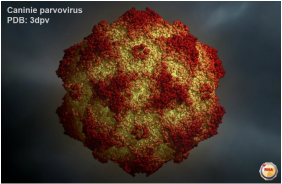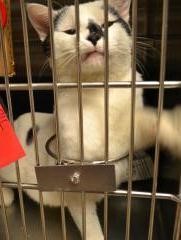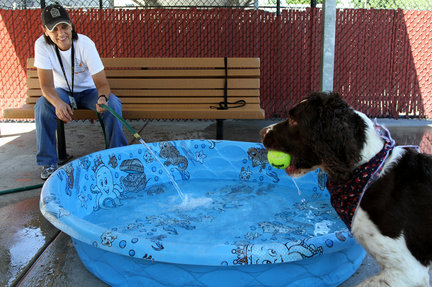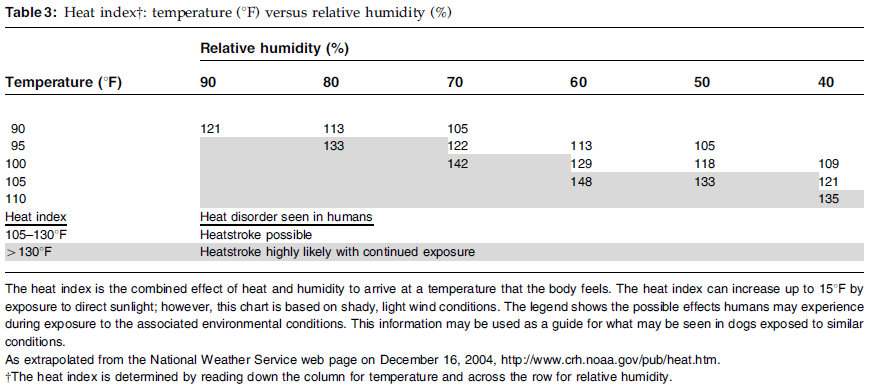
Canine parvovirus is one of the most potentially devastating viruses facing shelter populations. Control of this virus requires an effective vaccination program, quick recognition, quarantine, and thorough environmental disinfection. This non-enveloped, single-stranded DNA virus is resistant to extreme heat, cold, and dry conditions, and can remain in the environment for months to years.
Parvovirus attacks the epithelium of the small intestine causing severe, bloody diarrhea and life-threatening dehydration. Other clinical signs include vomiting, lethargy, loss of appetite, and a high fever. The virus also targets the bone marrow, causing a low white blood cell count and a weakened immune system. Although this virus can cause disease in any unvaccinated dog, it most severely affects puppies because they are immunologically vulnerable and very susceptible to infection after the waning of their maternal antibodies. Furthermore, Parvovirus is easily transmitted in a shelter setting through exposure to infected feces and fomites. Viral shedding can occur in infected animals before the appearance of clinical signs, making the control of this disease even more difficult.
Vaccination is essential in preventing the spread of parvovirus.
A strategic vaccination program is the most important factor in the management of this disease. The modified live vaccine protects against all strains of parvovirus and is effective within 3-5 days. All adult dogs and puppies over 4 weeks should be vaccinated immediately upon arrival to the shelter. Because of maternal antibody interference, puppies should be revaccinated every 2 weeks until they are about 5 months old.
Until puppies are fully vaccinated, they are very susceptible and should be protected from potential exposure. Puppies should not be walked through the shelter or outdoor enclosures used by the general population. Staff members should always wear clean gloves when interacting with the puppies and when cleaning their kennels. If possible, puppies should be sent to foster or adopted out of the shelter as soon as possible to minimize their risk of exposure.
Animals with a high risk of infection should be isolated in order to protect the rest of the shelter population. The incubation period of this virus is typically about 3-4 days, but can extend up to 2 weeks. Therefore, a quarantine period of 2 weeks is sufficient to reveal whether an animal will show signs of disease.
To Quarantine or Not to Quarantine
The in-house fecal ELISA snap test is a quick and reliable way to diagnose all current strains of canine parvovirus. Only animals showing clinical signs or with a history of recent exposure should be tested. Although PCR testing of fecal samples at a specialized laboratory can distinguish between the different strains of the virus, it is unnecessary in a shelter setting and will not change the treatment plan. Because of the virus’s effect on the bone marrow, a low white blood cell count identified by a blood smear is characteristic of parvovirus infection. Lastly, necropsy may reveal segmental enteritis, the classic pathological presentation of this disease.
When an animal has been exposed to parvovirus, it is important to assess the risk of infection and determine whether the animal should be put into quarantine. The likelihood of infection after exposure depends on the presence of maternal antibodies, the animal’s vaccination status, the amount of environmental contamination, and the proximity to the infected animal. Antibody titer testing is useful when deciding whether to quarantine asymptomatic dogs that have been exposed. Clinically healthy adult dogs with a history of vaccination are at low risk of infection and should not undergo titer testing.
Titer testing doesn’t require an outside lab- you can order the kits yourself at (http://vaccicheck.com) and perform them “in-house.” They require a small amount of blood and, at the time of this writing, cost approximately $16 per test (you must purchase a whole kit containing 12 tests). See below for how you can use titer test results to identify low-risk and high-risk dogs. The cost of the tests are well worth the chance to say, “This dog is at low risk for parvo virus and can be adopted out now! No quarantine needed” (not to mention the decrease in length of shelter stay)!
Snap tests used in combination with titer testing in exposed puppies can help determine their infection status. For example, a puppy with a positive snap test and a positive titer is most likely infected and should be separated from other dogs. A negative snap test and positive titer without clinical signs of disease (i.e. puppy appears completely healthy) is likely protected and low-risk. A puppy that is not shedding virus but is also susceptible to infection would have both a negative snap test and a negative titer. The virus may be in the incubation period, and the puppy should be quarantined for two weeks. Puppies should be bathed before entering quarantine to prevent self-infection from virus particles on the fur. Staff members should use gloves, shoe covers, and gowns when cleaning the kennels. Disinfecting equipment should be specific to each individual kennel to avoid cross-contamination. Dogs that do not show clinical signs after two weeks can safely re-enter the general population.
Disinfection of Shelter
Because parvovirus can survive in the environment for years, thorough disinfection is a vital step in the control of this disease. Ineffective cleaning practices can lead to persistent infections in the shelter. Household bleach (5% sodium hypochlorite) at 1:32 dilution will successfully kill parvovirus, but only if the surface has been pre-cleaned! It is important to remove all organic matter from the surface being disinfected, as it inactivates the bleach. Two disinfectants that are more effective in the presence of organic matter in comparison to bleach include potassium peroxymonosulfate (Trifectant) and accelerated hydrogen peroxide (Accel). Outside enclosures present a more difficult challenge for environmental decontamination. Grass or dirt pens can be flooded, dried, and sprayed with Accel. However, because these methods are not completely effective, susceptible puppies should not use outdoor enclosures that have had recent viral exposure.
Summary
Parvovirus can be treated in shelters that have the resources and isolation capabilities necessary to prevent an outbreak. The treatment is mainly supportive care incorporating anti-emetics, intravenous or subcutaneous fluids, and in severe cases, blood transfusions. Because of the weakened immune system, antibiotics are given to prevent secondary bacterial infections. Animals should be isolated for 2 weeks following recovery, since viral shedding can occur up to 14 days after the resolution of clinical signs. If quarantine for that length of time is not feasible, you can feel reasonably confident that the dog is no longer shedding if two parvo snap tests, run after resolution of clinical signs and several days apart, are negative. In shelters that do not have the ability to treat animals with parvovirus, humane euthanasia is sometimes performed to avoid endangering the rest of the shelter population.
Parvovirus poses a great challenge to shelter veterinarians. This highly contagious and resistant virus can rapidly spread through a shelter, potentially threatening the lives of many young animals. Fortunately, this disease can be successfully managed through widespread vaccination, strict hygiene practices, and quick isolation of sick animals. A well-trained and dedicated staff that routinely monitors the health of all puppies can help prevent devastating outbreaks. By implementing these management strategies, shelters can save lives and protect their most vulnerable population.
References
American Veterinary Medical Foundation. Canine Parvovirus. 2015. <https://owl.english.purdue.edu/owl/resource/747/08/>.
Baker Institute for Animal Health. Cornell University College of Veterinary Medicine. Animal Health Article: Canine Parvovirus. 2014. <http://www.vet.cornell.edu/baker/about/articles/CanineParvovirus.cfm>.
Koret Shelter Medicine Program. UC Davis Veterinary Medicine. Canine: Parvovirus (CPV). 2015. <http://www.sheltermedicine.com/library/canine-parvovirus-cpv>.
The Merck Veterinary Manual. Canine Parvovirus. Merck Sharp & Dohme Corp. 2009-2015. <http://www.merckvetmanual.com/mvm/digestive_system/diseases_of_the_stomach_and_intestines_in_small_animals/canine_parvovirus.html>.
Parvovirus attacks the epithelium of the small intestine causing severe, bloody diarrhea and life-threatening dehydration. Other clinical signs include vomiting, lethargy, loss of appetite, and a high fever. The virus also targets the bone marrow, causing a low white blood cell count and a weakened immune system. Although this virus can cause disease in any unvaccinated dog, it most severely affects puppies because they are immunologically vulnerable and very susceptible to infection after the waning of their maternal antibodies. Furthermore, Parvovirus is easily transmitted in a shelter setting through exposure to infected feces and fomites. Viral shedding can occur in infected animals before the appearance of clinical signs, making the control of this disease even more difficult.
Vaccination is essential in preventing the spread of parvovirus.
A strategic vaccination program is the most important factor in the management of this disease. The modified live vaccine protects against all strains of parvovirus and is effective within 3-5 days. All adult dogs and puppies over 4 weeks should be vaccinated immediately upon arrival to the shelter. Because of maternal antibody interference, puppies should be revaccinated every 2 weeks until they are about 5 months old.
Until puppies are fully vaccinated, they are very susceptible and should be protected from potential exposure. Puppies should not be walked through the shelter or outdoor enclosures used by the general population. Staff members should always wear clean gloves when interacting with the puppies and when cleaning their kennels. If possible, puppies should be sent to foster or adopted out of the shelter as soon as possible to minimize their risk of exposure.
Animals with a high risk of infection should be isolated in order to protect the rest of the shelter population. The incubation period of this virus is typically about 3-4 days, but can extend up to 2 weeks. Therefore, a quarantine period of 2 weeks is sufficient to reveal whether an animal will show signs of disease.
To Quarantine or Not to Quarantine
The in-house fecal ELISA snap test is a quick and reliable way to diagnose all current strains of canine parvovirus. Only animals showing clinical signs or with a history of recent exposure should be tested. Although PCR testing of fecal samples at a specialized laboratory can distinguish between the different strains of the virus, it is unnecessary in a shelter setting and will not change the treatment plan. Because of the virus’s effect on the bone marrow, a low white blood cell count identified by a blood smear is characteristic of parvovirus infection. Lastly, necropsy may reveal segmental enteritis, the classic pathological presentation of this disease.
When an animal has been exposed to parvovirus, it is important to assess the risk of infection and determine whether the animal should be put into quarantine. The likelihood of infection after exposure depends on the presence of maternal antibodies, the animal’s vaccination status, the amount of environmental contamination, and the proximity to the infected animal. Antibody titer testing is useful when deciding whether to quarantine asymptomatic dogs that have been exposed. Clinically healthy adult dogs with a history of vaccination are at low risk of infection and should not undergo titer testing.
Titer testing doesn’t require an outside lab- you can order the kits yourself at (http://vaccicheck.com) and perform them “in-house.” They require a small amount of blood and, at the time of this writing, cost approximately $16 per test (you must purchase a whole kit containing 12 tests). See below for how you can use titer test results to identify low-risk and high-risk dogs. The cost of the tests are well worth the chance to say, “This dog is at low risk for parvo virus and can be adopted out now! No quarantine needed” (not to mention the decrease in length of shelter stay)!
Snap tests used in combination with titer testing in exposed puppies can help determine their infection status. For example, a puppy with a positive snap test and a positive titer is most likely infected and should be separated from other dogs. A negative snap test and positive titer without clinical signs of disease (i.e. puppy appears completely healthy) is likely protected and low-risk. A puppy that is not shedding virus but is also susceptible to infection would have both a negative snap test and a negative titer. The virus may be in the incubation period, and the puppy should be quarantined for two weeks. Puppies should be bathed before entering quarantine to prevent self-infection from virus particles on the fur. Staff members should use gloves, shoe covers, and gowns when cleaning the kennels. Disinfecting equipment should be specific to each individual kennel to avoid cross-contamination. Dogs that do not show clinical signs after two weeks can safely re-enter the general population.
Disinfection of Shelter
Because parvovirus can survive in the environment for years, thorough disinfection is a vital step in the control of this disease. Ineffective cleaning practices can lead to persistent infections in the shelter. Household bleach (5% sodium hypochlorite) at 1:32 dilution will successfully kill parvovirus, but only if the surface has been pre-cleaned! It is important to remove all organic matter from the surface being disinfected, as it inactivates the bleach. Two disinfectants that are more effective in the presence of organic matter in comparison to bleach include potassium peroxymonosulfate (Trifectant) and accelerated hydrogen peroxide (Accel). Outside enclosures present a more difficult challenge for environmental decontamination. Grass or dirt pens can be flooded, dried, and sprayed with Accel. However, because these methods are not completely effective, susceptible puppies should not use outdoor enclosures that have had recent viral exposure.
Summary
Parvovirus can be treated in shelters that have the resources and isolation capabilities necessary to prevent an outbreak. The treatment is mainly supportive care incorporating anti-emetics, intravenous or subcutaneous fluids, and in severe cases, blood transfusions. Because of the weakened immune system, antibiotics are given to prevent secondary bacterial infections. Animals should be isolated for 2 weeks following recovery, since viral shedding can occur up to 14 days after the resolution of clinical signs. If quarantine for that length of time is not feasible, you can feel reasonably confident that the dog is no longer shedding if two parvo snap tests, run after resolution of clinical signs and several days apart, are negative. In shelters that do not have the ability to treat animals with parvovirus, humane euthanasia is sometimes performed to avoid endangering the rest of the shelter population.
Parvovirus poses a great challenge to shelter veterinarians. This highly contagious and resistant virus can rapidly spread through a shelter, potentially threatening the lives of many young animals. Fortunately, this disease can be successfully managed through widespread vaccination, strict hygiene practices, and quick isolation of sick animals. A well-trained and dedicated staff that routinely monitors the health of all puppies can help prevent devastating outbreaks. By implementing these management strategies, shelters can save lives and protect their most vulnerable population.
References
American Veterinary Medical Foundation. Canine Parvovirus. 2015. <https://owl.english.purdue.edu/owl/resource/747/08/>.
Baker Institute for Animal Health. Cornell University College of Veterinary Medicine. Animal Health Article: Canine Parvovirus. 2014. <http://www.vet.cornell.edu/baker/about/articles/CanineParvovirus.cfm>.
Koret Shelter Medicine Program. UC Davis Veterinary Medicine. Canine: Parvovirus (CPV). 2015. <http://www.sheltermedicine.com/library/canine-parvovirus-cpv>.
The Merck Veterinary Manual. Canine Parvovirus. Merck Sharp & Dohme Corp. 2009-2015. <http://www.merckvetmanual.com/mvm/digestive_system/diseases_of_the_stomach_and_intestines_in_small_animals/canine_parvovirus.html>.





